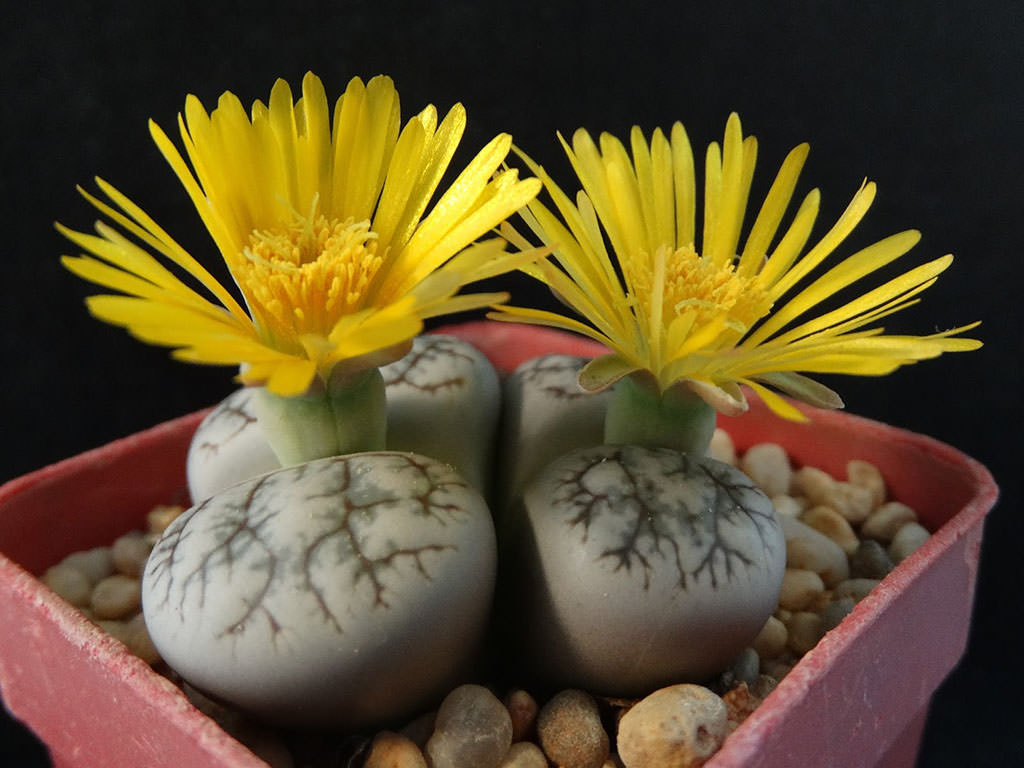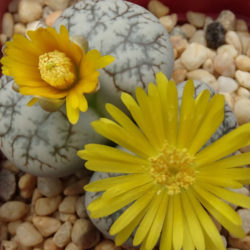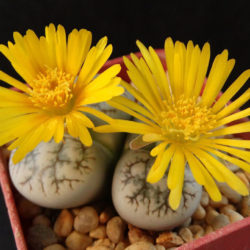Scientific Name
Lithops werneri Schwantes & Jacobsen
Common Name(s)
Living Stones
Scientific Classification
Family: Aizoaceae
Subfamily: Ruschioideae
Tribe: Ruschieae
Genus: Lithops
Origin
This species is native to Namibia, restricted to an area 40 km southeast of Usakos, growing in broken granite at the foot of the Erongo Mountains.
Description
Lithops werneri is a dwarf succulent with bodies of two opposite plump, usually pale grey or pale greenish-grey leaves with several branched dark greenish- to yellowish-brown lines and numerous blue pellucid dots. It grows solitary or forms clumps of up to 25 bodies. The bodies are up to 0.8 inches (2 cm) tall and up to 0.6 inches (1.5 cm) wide. The top surface of the bodies is windowless and usually the same color as the sides. Flowers are yellow, about 1 inch (2.5 cm) in diameter, and appear from the fissure between the leaves in fall. Fruits are usually 6-chambered capsules.
Etymology
The specific epithet "werneri (WER-ner-ee)" honors Werner Triebner (fl. c. 1950), a South African farmer, son of Wilhelm Triebner of Windhoek, and the first collector of this species.

How to Grow and Care for Lithops werneri
Light: A sunny windowsill where the plant receives 4 to 5 hours of direct sunlight during the early part of the day and partial shade during the afternoon is the perfect spot to grow your L. werneri. You may place the pot on the balcony or in the garden from spring to fall.
Soil: L. werneri thrives best in a growing medium that will drain quickly. Use a commercial soil mix for succulents or make your own potting mix.
Hardiness: High temperatures are not a problem for this plant as long as there is plenty of fresh air, but it is not a cold-hardy succulent. L. werneri can withstand temperatures as low as 30 to 50 °F (-1.1 to 10 °C), USDA hardiness zones 10a to 11b.
Watering: Like all Lithops, this succulent has a specific yearly cycle of growth, and it is important to water only during certain stages, but it is also important to keep the soil dry at other stages of its growth. How often you need to water your L. werneri depends on how quickly the potting mix dries out. It is essential to let the soil dry out between waterings. Stop watering during the winter to allow the old leaf pair to dry out and the new pair to develop.
Fertilizing: L. werneri does not need to be fertilized. It will thrive without any feeding. If you decide to feed, use a fertilizer with high potassium and low nitrogen levels.
Repotting: This small succulent will happily stay in the same pot for several decades. The common reason for repotting is to divide the plant or to allow space for clusters to grow. Repot only when its growing season starts.
Propagation: L. werneri is most often grown from seeds. If you have a multi-headed plant, it can also be propagated by division. Sow the seeds during the summer.
Learn more at How to Grow and Care for Lithops.
Toxicity of Lithops werneri
L. werneri is non-toxic and safe to have around children and pets.
Links
- Back to genus Lithops
- Succupedia: Browse succulents by Scientific Name, Common Name, Genus, Family, USDA Hardiness Zone, Origin, or cacti by Genus
Photo Gallery


